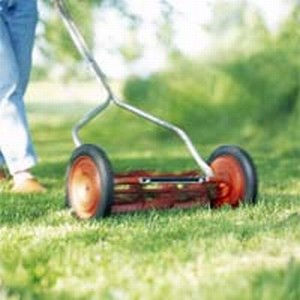News and Events
September 24, 2007

Fall is the Best Time to Rejuvenate Your Lawn
Fall
is the Best Time
to
Rejuvenate Your Lawn
(HIT)-Horticultural experts generally agree that proper lawn
care in the Fall has greater impact than similar efforts in the Spring or any
other season for rejuvenating a lawn throughout the year. Fall is the season
when turfgrass growth begins to slow. According to the Lawn Institute, a
Chicago-based non-profit group, it is also a good time to help your grass
develop the stamina it will need to survive the stress of winter and get a head
start for the coming Spring.
Early October is generally the right time to focus
additional attention for cool-season (northern
To achieve maximum benefit for year-round results, Fall lawn care requires a
number of different efforts, including mowing, removal or mulching lawn debris,
aerating, fertilizing and watering. The sequence of these efforts is as
important as how they are performed.
Mowing
In addition to the immediate beauty of a freshly cut lawn, mowing in
accordance with the following guidelines can help generate and maintain
healthier turfgrass plants.
• Make sure the mower blade is
sharp-the ragged cut made by a dull blade tends to shred the grass blade tips,
exposing a larger surface area to disease, pest and water loss.
• Set the proper cutting height-the
higher cutting height used during the Summer (when the photosynthetic processes
in the leaf tissues are at their peak) should have progressed to a lower
cutting height late in the Fall when the plant begins to store food reserves.
The lower cutting height, without scalping, helps harden and strengthen the
plants' roots and crown with increased nutrients that would otherwise have been
used by longer grass blades.
• Lawn debris-up to one inch of
leaves can be mulched to serve as a protective cover during the coming cold
season. However, clumps or large leaves, such as often accumulate in low spots,
could trap dampness and become a breeding spot for diseases and pests. If in
doubt, remove the debris with a mulching mower and dump it the compost bin for
recycling into nutrient-rich soil for future garden use.
Aerating The Soil
After a year of a being trampled upon by various activities
that tend to pack the soil, the grass roots need a breath of fresh air (oxygen)
for respiration that only proper aeration can provide. This helps the root
systems better establish themselves for the coming winter. Aeration should take
place approximately two weeks before applying the year's final fertilizer, or
five to six weeks before the first frost.
The most effective aerator has hollow tines that penetrate
the ground and remove core plugs of soil that are expelled as each successive
plug is removed, leaving a vent for true aeration. Although a freshly aerated
lawn appears a bit unsightly with numerous plugs laying all over it, they will
eventually dissolve, returning nutrients to the soil for use by the grass.
The unsightly appearance can be reduced and the plug dissolving
process speeded up by mowing with a low-cutting blade. Be sure to remove the
grass clipping bag and then mow the entire lawn in a left-to-right pattern,
followed by an up-and-down pattern to assure even break-up and spreading of the
aeration plugs. After mowing, watering the lawn further helps dissolve the
aeration plugs.
Fertilizing/Weed
Control
The Fall application of a weed-and-feed type fertilizer
provides longer lasting benefits to a lawn than that of any other time of the
year, according to the Lawn Institute. Fertilizer should be timed about one
month before the first frost. It is very important to read, understand and
follow instructions on the fertilizer label. The following information should
take the mystery out of how much and which type to fertilizer to buy, and how
to apply it efficiently.
• How much-The fertilizer bag label
advises how many square feet the product will cover; any portion not used will
be just as effective next year, if stored in a dry area.
• Which type-Any reputable lawn and
garden retailer will be able to recommend the best fertilizer mixture for a
particular time of the year. In the Fall, turfgrass needs less nitrogen (N) but
higher ratios of phosphorus (P) and potassium (K) to encourage root growth and
harden the grass plants for the coming winter.
• Proper application-To assure
uniform coverage with either a broadcast spreader or a drop spreader, follow
these simple steps:
1. Adjust the spreader application dial to one-half of the fertilizer
bag's recommended setting and make the first application in an up-and-down pattern,
covering the entire lawn.
2. Begin the second application immediately, in a left-to-right pattern,
and continue over the entire lawn. (HINT: Use two small flags to mark the
beginning and end of each row as you apply the fertilizer-small, brightly
colored flags with stiff wire shafts work best.)
Article Courtesy of the The Lawn Institute








